Introduction
Ticks and fleas infestation on dogs is very dangerous and in some cases it can even prove fatal. It is important for a dog owner to understand what tick and flea infestations are, so that your furry friend always stays happy and healthy.
Tick and flea infestation in dog act just like a slow poision.This article explains everything about tick and flea infestation in a simple and friendly way – from signs to prevention.
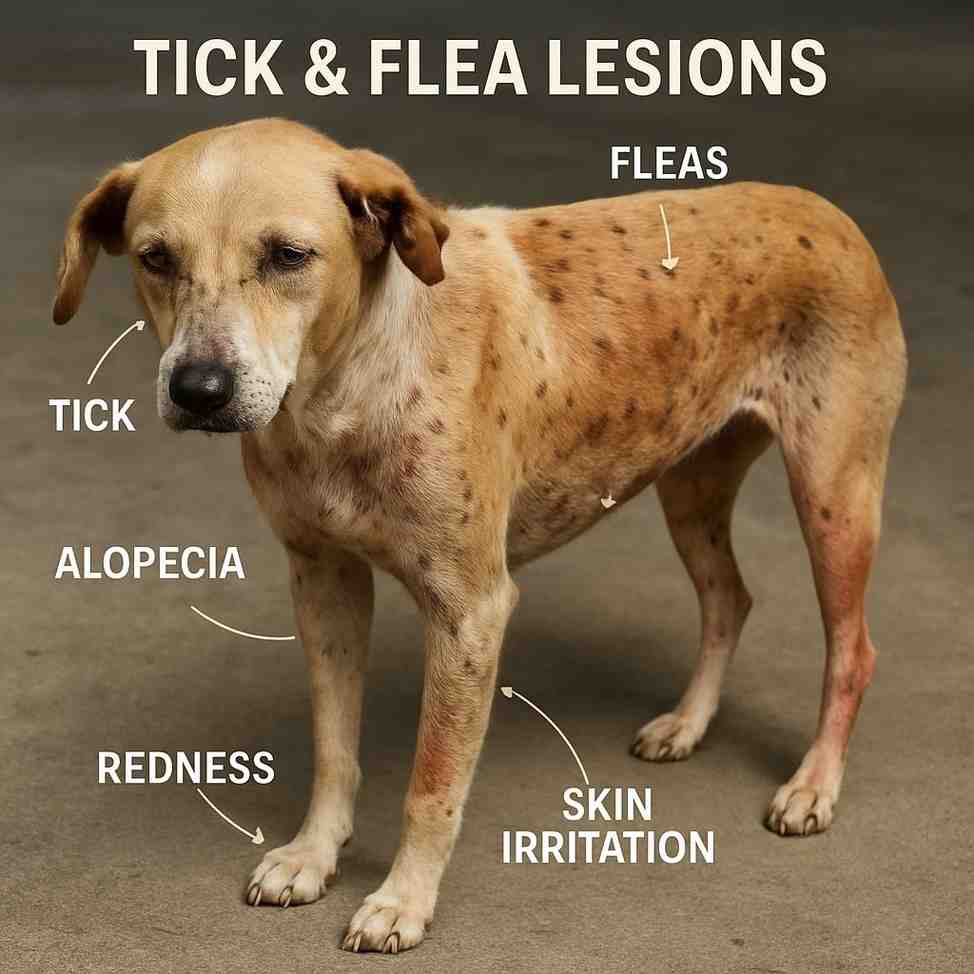
Table of Contents
What Are Ticks And Fleas?
Ticks and fleas are tiny external parasites that feed on blood from animals and humans. In cases of Ticks and Fleas Infestation on Dogs, these pests cause itching, irritation, and serious diseases if left untreated, making early prevention essential.
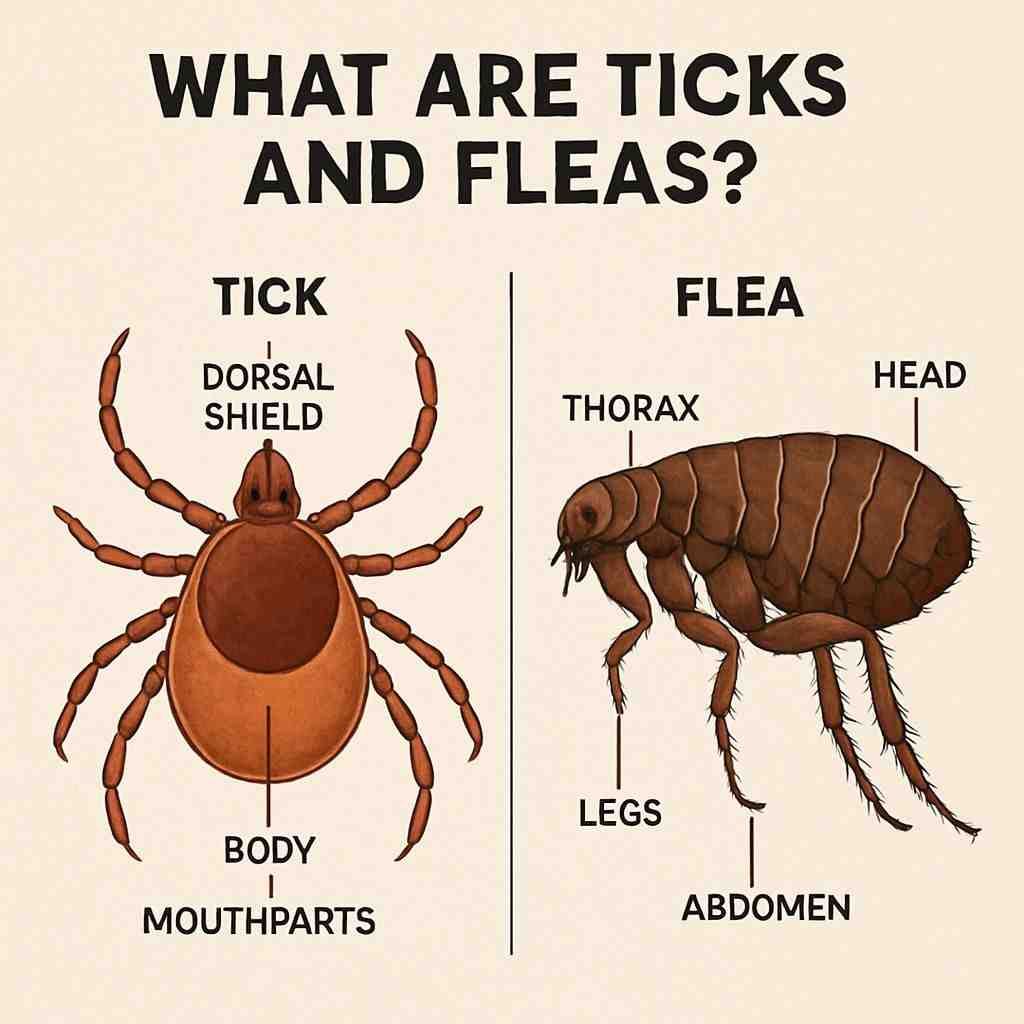
| Characteristic | Ticks | Fleas |
|---|---|---|
| Type of organism | Arachnid (related to spiders & mites) | Insect (related to flies & beetles) |
| Body parts | divided in 2 main parts: head & body, with 8 legs | divided in 3 main parts: head, thorax & abdomen, with 6 legs |
| Size | 1–5 mm (can swell much larger after feeding) | About 1–3 mm (does not swell much) |
| Color | Brown, black, or reddish | Dark brown or reddish-brown |
| Movement | Crawls slowly | Jumps long distances using strong hind legs |
| Where they live | Grassy areas, bushes, animal skin | Animal fur, carpets, bedding, cracks in floors |
| How they attach | Bites and burrows head into skin to suck blood | Bites skin but stays in fur or moves around |
| Feeding | Feeds on blood for days at a time | Feeds on blood but takes quick, small meals |
| Lifespan | Weeks to months (can survive without food for months) | Few weeks to months, depending on environment |
| Diseases they can transfer | Lyme disease, Ehrlichiosis, Babesiosis, anemia from heavy infestations | Flea allergy dermatitis, tapeworms, skin infections, anemia if severe |
| Egg-laying capacity | Lays thousands of eggs on ground or in environment | Lays eggs in animal’s fur, which fall into surroundings |
| Main Preferred season | Warm, humid seasons, but some active year-round | Warm, humid seasons, but can live indoors year-round |
Why Ticks And Fleas Infestation On Dogs Is A Serious Problem

Ticks and Fleas Infestation on Dogs leads to severe itching, allergic reactions, anemia, and even life-threatening infections. These parasites also transmit dangerous diseases, posing a health risk to both pets and their owners if not properly managed.
| Reason | Ticks | Fleas |
|---|---|---|
| Cause itching & discomfort | Bite and stay stuck in the skin, causing irritation | Bite repeatedly, making dogs scratch, lick, and chew |
| Skin problems | Can cause redness, swelling, sores where they attach | Cause rashes, hair loss, and flea allergy dermatitis |
| Blood loss (anemia) | In heavy infestations, suck a lot of blood, weakening the dog | In large numbers, fleas can also cause serious blood loss |
| Spread diseases | Can carry and pass on Lyme disease, Ehrlichiosis, Babesiosis | Can transmit tapeworms and bacteria like Bartonella |
| Infections | The wound from a tick bite can get infected | Flea bites and scratching can lead to skin infections |
| Weaken the dog’s immune system | Stress and diseases from ticks can lower immunity | Allergies and stress from fleas can also weaken health |
| Infest home & environment | Ticks drop eggs in grass or yard, making it hard to control | Fleas lay eggs that spread into carpets, beds, and furniture |
How Do Dogs Get Ticks and Fleas?
Dogs often get ticks and fleas from grass, other animals, or contaminated surroundings. Ticks and Fleas Infestation on Dogs spreads rapidly through outdoor exposure, making routine checks and preventive treatments vital to protect your dog’s health year-round.
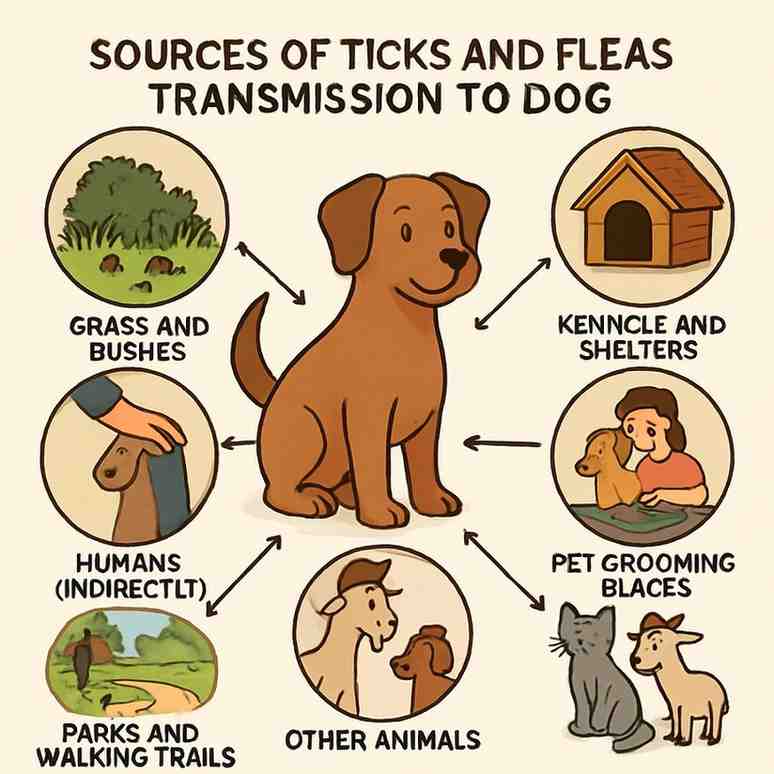
| Source / Place | How Dogs Pick Them Up |
|---|---|
| Grass and bushes | Ticks and fleas hide in tall grass and shrubs and jump or crawl onto dogs when they pass by. |
| Other animals | Dogs can catch fleas or ticks from other infested dogs, cats, wildlife (like squirrels, rabbits, or deer). |
| Kennels and shelters | Close contact with many animals in kennels or shelters increases the risk of infestation. |
| Parks and walking trails | Fleas and ticks can live in areas where many dogs play and walk, waiting for a host. |
| Home and yard | Fleas can survive in carpets, furniture, or outdoor shady areas and jump on your dog. |
| Humans (indirectly) | People can bring flea or tick eggs into the house on shoes or clothes, which then find the dog. |
| Pet grooming places | Shared grooming tools or bedding in salons can also spread fleas. |
Signs Your Dog Has Ticks or Fleas
Common signs of Ticks and Fleas Infestation on Dogs include constant scratching, red patches, hair loss, visible flea dirt, and restlessness. Close inspection of your dog’s fur and skin can help detect early infestation before it worsens.
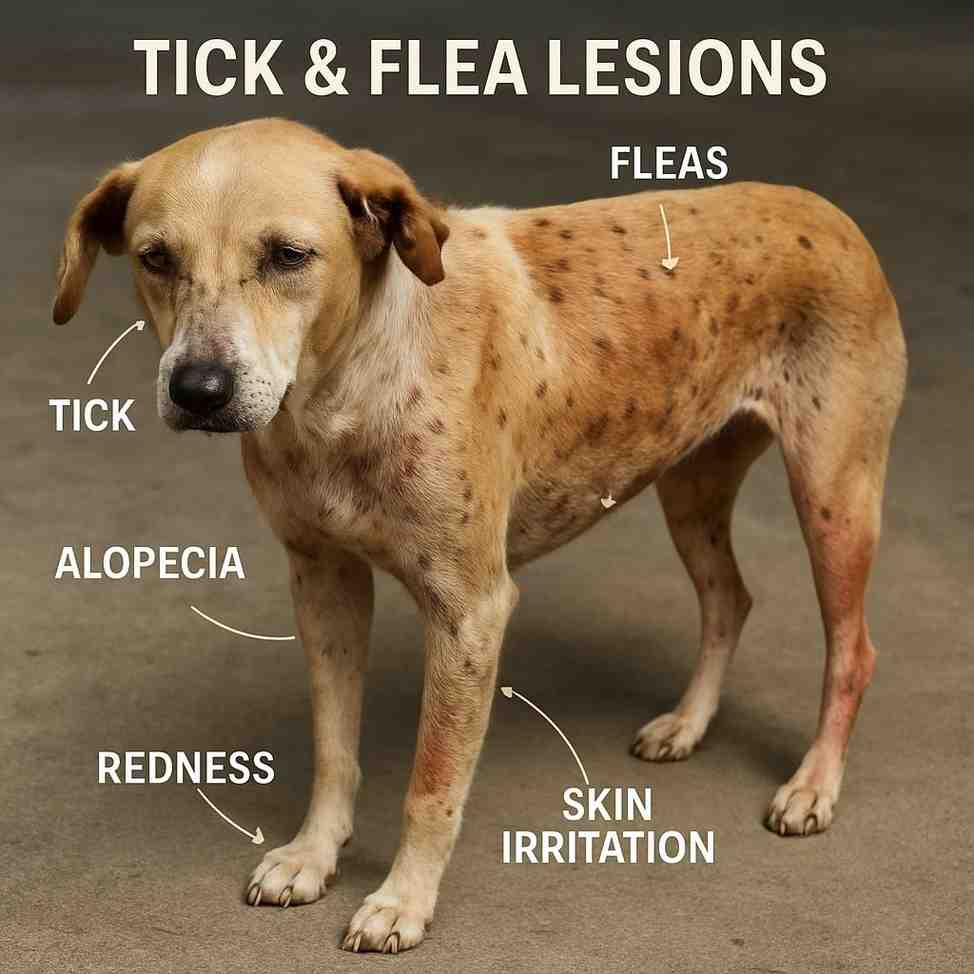
| Sign | Ticks | Fleas |
|---|---|---|
| Visible Parasites | Small, flat, oval-shaped bugs attached to the skin, often brown or black | Tiny, dark brown, fast-moving specks in fur, often near neck or tail base |
| Skin Changes | Redness, swelling, or small bumps at the site where ticks are attached | Red, scabby patches or hot spots from scratching |
| Behavioral Changes | Lethargy, loss of appetite, or discomfort due to tick bites | Constant scratching, biting, or chewing at fur, especially around back |
| Debris or Residue | None, as ticks stay attached to the skin | Black specks (flea dirt) in fur, which turn red when wet |
| Common Areas | Found around ears, armpits, between toes, or under collar | Often near neck, belly, or base of tail |
How Ticks and Fleas Suck Blood & How Much They Can Take
During Ticks and Fleas Infestation on Dogs, these parasites attach to the skin and feed on blood for days. Heavy infestations can cause noticeable blood loss, weakness, and irritation, significantly affecting your dog’s comfort and overall health.
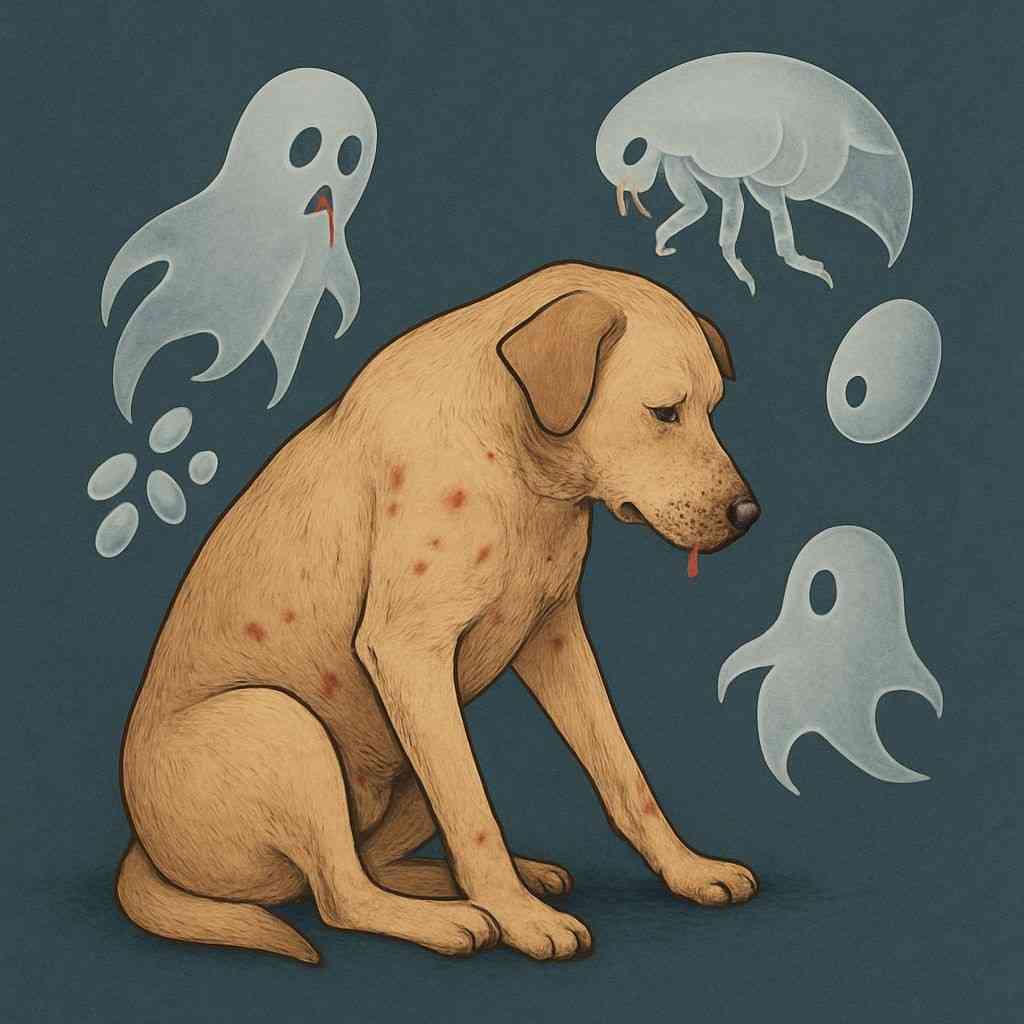
Ticks and fleas are both parasitic pests that can affect dogs, and their egg-laying habits contribute significantly to infestations. Understanding how many eggs a single tick or flea can lay, along with their reproductive behaviors, helps dog owners grasp the importance of early prevention and treatment.
| Parasite | Eggs Laid by a Single Female | Egg-Laying Period | Location of Eggs | Hatching Time |
|---|---|---|---|---|
| Tick | 3,000–6,000 eggs (varies by species) | Over a few weeks, laid in one batch | Off-host, in environment (e.g., soil, grass, leaf litter) | 2–12 weeks, depending on temperature and humidity |
| Flea | 500–2,000 eggs (up to 50 per day) | Over 2–3 months, laid daily | On-host (dog’s fur) and environment (e.g., bedding, carpets) | 2–14 days, depending on conditions |
How Ticks And Fleas Infestation On Dogs Cause Severe Blood Loss
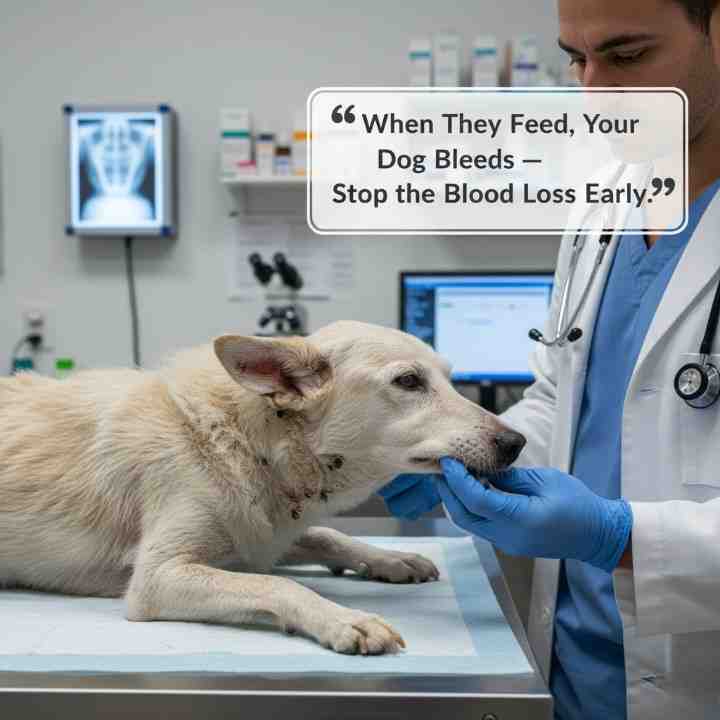
Severe Ticks and Fleas Infestation on Dogs can lead to chronic blood loss due to continuous feeding. Over time, this may cause anemia, pale gums, fatigue, and poor coat condition, especially in puppies or small-breed dogs.
| Feature | Ticks 🕷️ | Fleas 🪳 |
|---|---|---|
| How they attach? | Ticks use strong mouthparts like a tiny “harpoon” to pierce the dog’s skin and insert deep into the tissue. | Fleas use their sharp, straw-like mouth to quickly pierce the skin and suck blood. |
| How they stay on? | They glue themselves in place with saliva that also numbs the area so the dog feels less pain. | They cling to fur and skin using claws and jump away if disturbed. |
| How long they feed? | Ticks feed slowly, for several hours to even days, staying attached in one spot. | Fleas take quick, frequent blood meals — feeding many times a day. |
| How much blood they take? (per insect) | One tick can drink about 0.5–2 milliliters of blood during its feeding (depending on size & stage). | One flea drinks about 0.0005 milliliters of blood per meal, but bites many times a day. |
| What happens if many are present? | Dozens of ticks can cause noticeable blood loss, skin damage, and weakness (anemia). | Hundreds of fleas can drain enough blood to cause anemia, especially in puppies or sick dogs. |
Checking Your Dog for Ticks and Fleas
Regularly checking your dog for ticks and fleas is essential to catch infestations early and keep your pet healthy. Ticks and fleas can hide in your dog’s fur, but with a systematic approach, you can spot them before they cause problems.
| Step | Ticks | Fleas | Tips |
|---|---|---|---|
| Prepare Your Tools | Fine-tipped tweezers, gloves, magnifying glass, comb | Flea comb, white towel, soapy water | Work in a well-lit area to spot tiny parasites easily. |
| Inspect Common Areas | Check ears, armpits, between toes, neck, and under collar | Focus on neck, belly, base of tail, and groin area | Part fur gently to see the skin; fleas move fast, ticks stay attached. |
| Look for Signs | Small, flat, oval bumps attached to skin, often brown or black | Tiny, dark brown specks moving quickly or black flea dirt | Run a flea comb over fur; flea dirt turns red when wet on a white towel. |
| Feel for Bumps | Run fingers over skin to feel for ticks, which feel like small lumps | Not applicable, as fleas don’t stay attached | Check warm, hidden areas where ticks like to hide. |
| Post-Check Actions | Remove ticks with tweezers, clean bite area with antiseptic | Use flea comb to trap fleas, dip in soapy water to kill them | Monitor for irritation or lethargy; consult a vet if signs persist. |
Vet-Approved Products for Prevention of Tick and Flea Infestation on Dogs
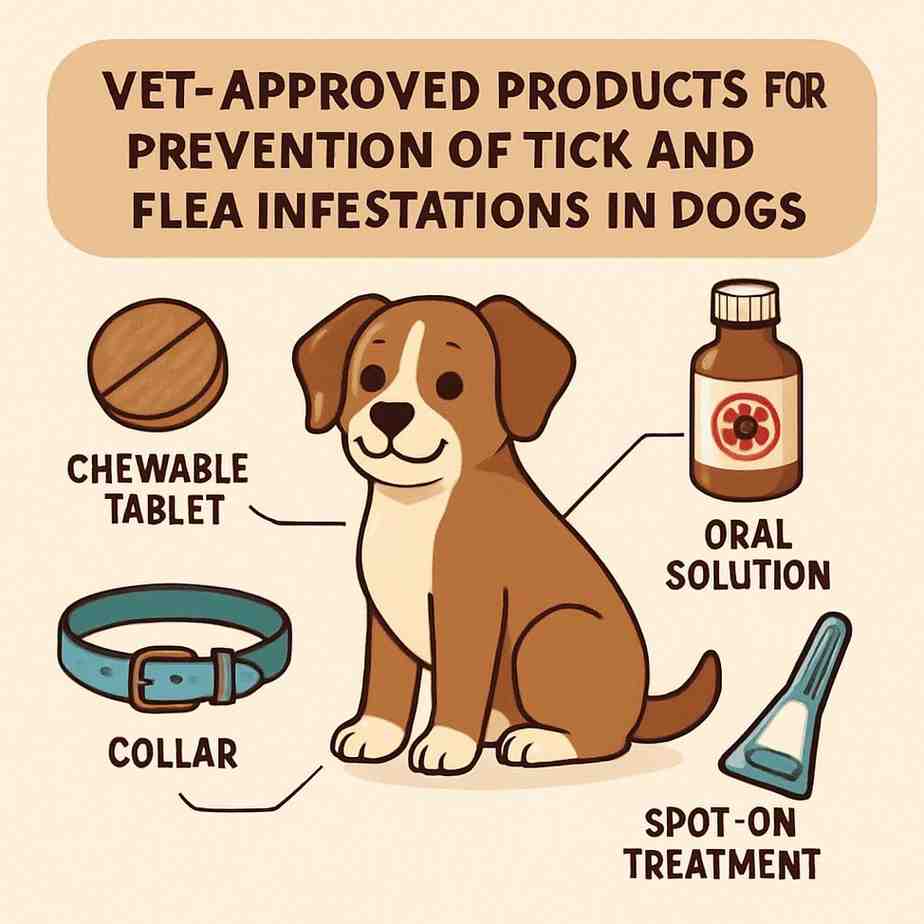
Preventing tick and flea infestations on dogs is essential for keeping your dog healthy and comfortable. Vet-approved products are designed to be safe and effective when used according to guidelines, offering various options to suit your dog’s needs and lifestyle.
| Product Type | Application Method | Common Active Ingredients | Duration of Protection | Key Considerations |
|---|---|---|---|---|
| Topical Treatments (Spot-On) | Applied to skin (e.g., between shoulder blades) | Imidacloprid, Permethrin, Fipronil, Selamectin | 1 month | Effective for fleas and ticks; some repel mosquitoes. Some products are toxic to cats, so keep treated dogs away from cats for 24 hours. Suitable for dogs 7+ weeks. |
| Oral Chewables/Tablets | Given by mouth (chewable or tablet) | Afoxolaner, Sarolaner, Fluralaner, Lotilaner | 1–3 months (some up to 12 weeks) | Fast-acting; kills fleas/ticks within hours. Some also protect against heartworms and worms. May cause rare neurological side effects (e.g., seizures) in dogs with history. |
| Flea and Tick Collars | Worn around neck | Flumethrin, Imidacloprid | Up to 8 months | Long-lasting; water-resistant. Low adverse event rate (0.116%). Avoid in multi-pet households with cats due to toxicity risk. |
| Flea Shampoos | Bathing application | Pyrethrins, S-Methoprene | Short-term (days to 1 week) | Kills fleas/ticks on contact but not for long-term prevention. Best for active infestations, followed by other preventatives. Avoid essential oils like tea-tree oil, which can be toxic. |
| Sprays | Sprayed on dog’s coat | Fipronil, Natural oils (e.g., peppermint) | Days to 1 month | Quick relief for infestations; not a primary preventative. Ensure dog doesn’t lick wet spray. Use with caution in multi-pet homes. |
| Oral Flea-Only Tablets | Given by mouth | Nitenpyram, Spinosad | 24 hours to 1 month | Fast-acting for fleas (kills within 30 minutes). Not for ticks. Best for immediate relief, not long-term prevention. |
| Combination Products | Chewable or topical | Lotilaner, Sarolaner, Moxidectin | 1 month | Broad-spectrum protection against fleas, ticks, heartworms, and intestinal worms. Prescription-only; ideal for comprehensive parasite control. |
Key Notes for Using Vet-Approved Products
When managing Ticks and Fleas Infestation on Dogs, always follow dosage instructions and veterinary advice carefully. Overuse or misuse of preventive products may cause skin irritation or toxicity, so proper application is crucial for safe results.
- Consult Your Vet: Always check with your veterinarian to ensure the product is safe for your dog’s age, weight, breed, and health status (e.g., MDR-1 gene mutation in breeds like Collies can cause sensitivity to certain ingredients).
- Prescription vs. OTC: Some products require a prescription, while others are over-the-counter. Prescription products are often more effective and safer.
- Year-Round Use: Vets recommend year-round prevention, as ticks and fleas can survive indoors or in mild climates, even in winter.
- Safety Precautions: Avoid using dog-specific products in households with cats due to toxicity risks. Watch for side effects like skin irritation or, rarely, seizures with isoxazoline-based products.
- Environmental Control: Combine preventatives with regular vacuuming, washing pet bedding, and yard maintenance to reduce the risk of tick and flea infestations.
Why It Matters: A tick and flea infestation can lead to serious health issues like Lyme disease, anemia, or tapeworm infections in dogs, and some diseases are zoonotic, affecting humans too. Choosing vet-approved products tailored to your dog’s needs ensures effective prevention while minimizing risks, keeping your dog happy and your home pest-free.
Home Remedies for Tick and Flea Infestation
Usually not recommended. For mild Ticks and Fleas Infestation on Dogs, natural remedies like apple cider vinegar, coconut oil, or neem spray can help. These methods offer chemical-free relief but may not replace professional treatment in severe infestations.
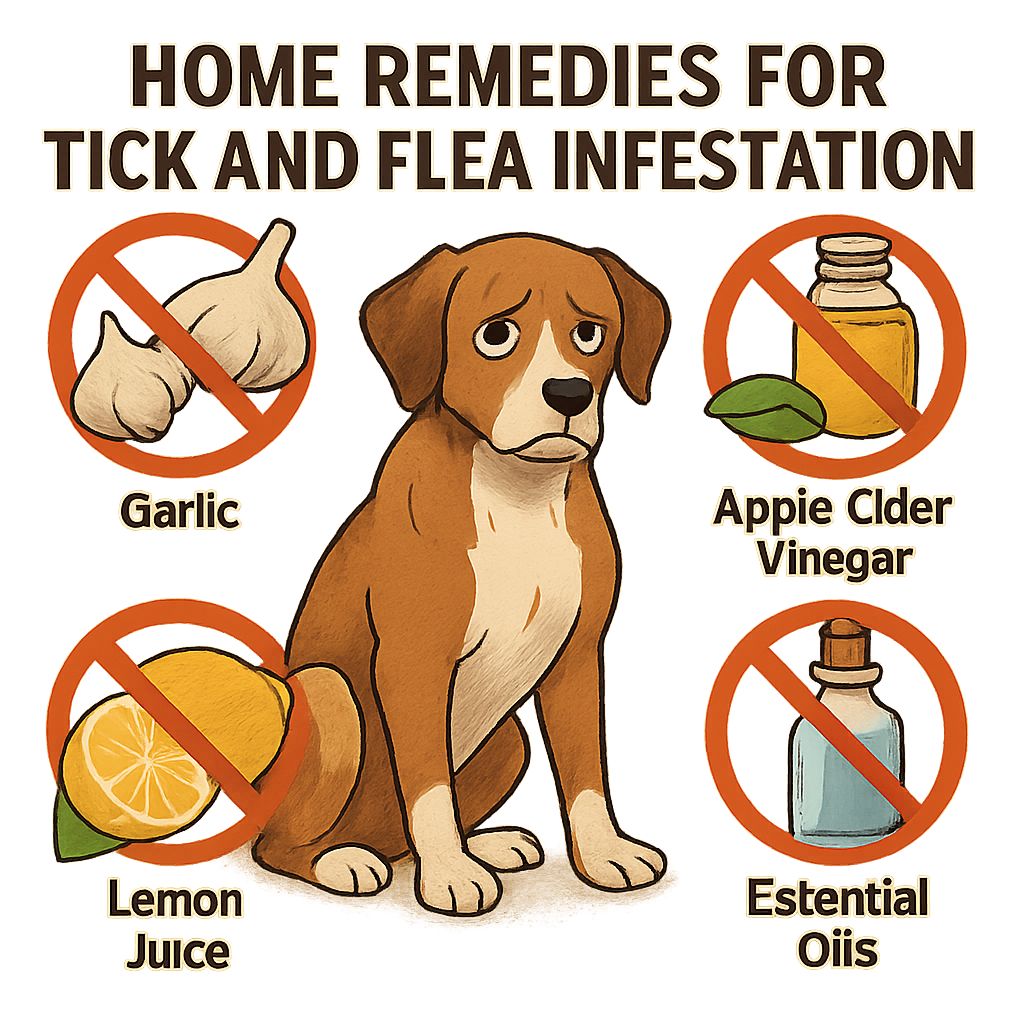
| Home Remedy | How It’s Used | How It Works | Limitations |
|---|---|---|---|
| Apple Cider Vinegar | Mix 1:1 with water, spray on dog’s coat, or add to drinking water | Creates an acidic environment that may deter fleas; no effect on ticks | Limited evidence; doesn’t kill fleas or ticks, only repels some. May irritate skin or upset stomach if ingested. |
| Diatomaceous Earth (Food-Grade) | Sprinkle on dog’s coat or bedding, avoiding eyes and nose | Dehydrates fleas by damaging their exoskeleton; less effective on ticks | Slow-acting; messy and can irritate lungs if inhaled. Not effective for heavy infestations. |
| Essential Oils (e.g., Lavender, Peppermint) | Dilute with carrier oil, apply to collar or coat | Repels fleas and ticks with strong scent | Toxic if overused (e.g., tea tree oil); inconsistent results. Not safe for all dogs, especially those with sensitive skin. |
| Lemon Spray | Boil lemon slices in water, cool, and spray on dog’s coat | Citric acid may repel fleas; no significant effect on ticks | Weak repellent; doesn’t kill parasites or prevent eggs from hatching. May irritate skin. |
| Manual Tick Removal | Use tweezers to pull ticks out, clean with alcohol | Removes individual ticks to prevent disease transmission | Effective for single ticks but doesn’t address infestations or prevent reinfestation. Risk of leaving tick parts in skin. |
| Dish Soap Bath | Mix mild dish soap with water, bathe dog | Traps and drowns fleas on contact | Short-term relief; doesn’t prevent reinfestation or kill eggs. Ineffective against ticks. |
When to Use Home Remedies
Home remedies can be a supplementary measure in very mild cases or as an immediate step while waiting for vet advice (e.g., using dish soap to drown fleas during a bath). Manual tick removal with tweezers is effective for single ticks but should be followed by vet-approved preventatives to avoid reinfestation. However, relying solely on home remedies for a tick and flea infestation is risky, as they don’t provide comprehensive control or protection against diseases.
Home Remedies vs. Veterinary Treatments

For the health of your dog and family, vet-approved products are the gold standard. They’re scientifically proven to kill ticks and fleas, prevent infestations, and reduce zoonotic risks. Always consult your vet to choose the right product (e.g., topical, oral, or collar) based on your dog’s needs, and combine with environmental cleaning (vacuuming, washing bedding) to keep your home pest-free. Home remedies may seem appealing, but they can’t match the reliability, safety, and long-term protection of vet-approved treatments to keep your dog happy and healthy.
✅ Home remedies might help a little if the problem is minor, but they are often not enough to protect your dog properly — and some can even be dangerous.
✅ Veterinary treatments are safer, stronger, and more effective at treating and preventing fleas and ticks.
How to Remove Ticks Safely

When dealing with Ticks and Fleas Infestation on Dogs, remove ticks using tweezers or a tick-removal tool. Grasp near the head and pull steadily. Avoid crushing ticks to prevent infection and clean the area afterward.
| Step | What to Do |
|---|---|
| 1. Gather supplies | You’ll need: fine-tipped tweezers or a tick-removal tool, gloves, antiseptic, and a small jar with rubbing alcohol. |
| 2. Stay calm & keep your dog still | Gently hold or have someone hold your dog so they don’t move while you remove the tick. |
| 3. Find the tick | Part the fur and look for a small brown, black, or grey lump attached to the skin — often on ears, neck, toes, or under collar. |
| 4. Grab the tick close to the skin | Using tweezers, grip the tick as close to the dog’s skin as possible. Don’t squeeze its body, just the head part. |
| 5. Pull straight out | With steady, even pressure, pull the tick out slowly. Do not twist or jerk — this can leave parts stuck in the skin. |
| 6. Check the bite area | Make sure the whole tick came out. If pieces are left, clean the area and contact your vet. |
| 7. Kill the tick | Place the tick in the jar of rubbing alcohol to kill it — don’t crush it with your fingers. |
| 8. Clean the area & your hands | Wipe the bite spot with antiseptic. Wash your hands and disinfect the tweezers. |
| 9. Watch your dog | Over the next few days, keep an eye on the bite area for redness, swelling, or signs of infection. If anything seems wrong, see a vet. |
🐾 Tips:
- Never burn a tick or apply chemicals like nail polish or oil while it’s attached — this can harm your dog and make the tick burrow deeper.
- Always wear gloves to avoid touching the tick directly.
- Check your dog regularly, especially after walks in grassy or wooded areas.
Preventing Fleas and Ticks: Tips and Tricks
| Tip or Trick | How It Helps |
|---|---|
| 1. Use vet-approved preventives | Spot-on treatments, pills, or collars from your vet can repel and kill fleas and ticks before they bite. |
| 2. Regular grooming & checks | Brushing your dog and checking their skin daily helps you find fleas or ticks early, before they multiply. |
| 3. Keep your yard clean | Mow the lawn, trim bushes, and remove leaf piles where ticks and fleas like to hide. |
| 4. Wash bedding & toys | Clean your dog’s bedding, blankets, and toys weekly to get rid of flea eggs and larvae. |
| 5. Vacuum your home often | Carpets, couches, and corners can hold flea eggs — vacuum regularly and empty the bag outside. |
| 6. Avoid high-risk areas | During peak seasons, avoid tall grass, wooded trails, and areas known for ticks. |
| 7. Bathe your dog regularly | A good bath with dog-safe shampoo helps keep the coat clean and can wash away some pests. |
| 8. Use flea combs | A flea comb can catch fleas and eggs if used slowly and carefully, especially around the neck and tail. |
| 9. Check after outdoor trips | After walks or play in parks, inspect your dog’s ears, belly, tail, and between toes for ticks or fleas. |
| 10. Treat all pets in the home | If you have more than one pet, treat all of them at the same time to avoid re-infestation. |
| 11. Ask your vet about vaccines | In some areas, dogs can get a Lyme disease vaccine to help protect against tick-borne illnesses. |
🌳 Maintain Your Yard

Yard maintenance plays a vital role in reducing Ticks and Fleas Infestation on Dogs. Keep grass short, trim bushes, and remove leaf piles to eliminate hiding spots where these parasites breed and wait for hosts.
| Step | What to Do | Why It Works |
|---|---|---|
| 1. Mow your lawn | Keep grass short and remove leaf piles and brush. | Fleas and ticks prefer cool, shady hiding places. |
| 2. Remove clutter | Clear wood piles, old furniture, or trash where pests can hide. | Reduces places for ticks and fleas to breed. |
| 3. Treat yard with sprays | Use outdoor flea and tick yard sprays or powders — choose pet-safe products. | Kills fleas and ticks living in the yard. |
| 4. Focus on shady & damp areas | Pay extra attention to shady spots under trees, decks, and along fences. | These are favorite flea and tick habitats. |
| 5. Keep wildlife out | Block holes and secure trash to keep wild animals (like raccoons or deer) away. | Wild animals can bring fleas and ticks to your yard. |
Seasonal Concerns: Are They Worse in Summer?

Ticks and Fleas Infestation on Dogs often peaks during warm and humid months. Summer conditions favor rapid parasite breeding, making year-round prevention and regular checks critical for your dog’s comfort and health.
| Season | What Happens With Fleas and Ticks? |
|---|---|
| Spring (March–May) | As temperatures warm up and humidity rises, both fleas and ticks become more active. This is the start of their peak season. |
| Summer (June–August) | This is usually the worst time for fleas and ticks because they thrive in warm, humid weather. Dogs spend more time outside, increasing exposure. |
| Autumn (September–November) | Ticks remain active in cooler weather, especially in fallen leaves and damp areas. Flea infestations can still continue indoors. |
| Winter (December–February) | In colder regions, ticks and fleas slow down outdoors, but indoor infestations can persist if homes stay warm and pets are untreated. |
Common Myths About Ticks and Fleas Infestation
| Myth | Why It’s Wrong (Truth) |
|---|---|
| 1. My dog stays indoors, so he can’t get fleas or ticks. | Fleas and ticks can hitch a ride into your home on people, other pets, or through cracks. Even indoor dogs can get infested. |
| 2. Fleas and ticks die off in winter. | They slow down outside but can survive indoors in warm houses all year. Some ticks remain active even in cold weather. |
| 3. Ticks fall from trees onto dogs. | Ticks don’t jump or fall from trees. They crawl up from grass or bushes and grab onto your dog’s legs or belly. |
| 4. Fleas are just a nuisance, not a health risk. | Fleas can cause serious skin problems, anemia, and even transmit tapeworms and bacteria to dogs and humans. |
| 5. Garlic or vinegar can prevent fleas and ticks. | There’s no scientific proof that these work, and garlic can actually be toxic to dogs. Always use vet-approved products. |
| 6. You only need to treat your dog when you see fleas or ticks. | By the time you see them, there may already be thousands of eggs in your home or yard. Prevention is key. |
| 7. Fleas only live on pets. | Adult fleas live on pets, but their eggs, larvae, and pupae spread all over your carpets, furniture, and yard. |
| 8. If one pet has fleas, the others don’t need treatment. | All pets in the house should be treated, because fleas quickly move between animals. |
| 9. Ticks are easy to remove by burning or smothering them. | These methods can hurt your dog and make the tick release more germs. It’s safer to use tweezers and pull gently. |
Estimated Impact of Tick and Flea Infestations on Dogs (Last 10 Years)
Over the past decade, cases of Ticks and Fleas Infestation on Dogs have risen globally due to warmer climates and increased travel. This growing trend highlights the importance of ongoing awareness and preventive veterinary care.
| Country/Region | Estimated Deaths & Notes (Last 10 Years) |
|---|---|
| India | Thousands of cases of canine babesiosis, ehrlichiosis, and severe anemia reported yearly; estimated hundreds of deaths/year in rural & urban areas due to lack of timely treatment. |
| United States | Tick-borne diseases (e.g., Lyme, ehrlichiosis) in dogs increasing yearly; exact deaths not documented, but thousands of severe cases needing hospitalization. |
| United Kingdom | Few deaths reported; improved awareness & vet care have reduced fatalities, but imported dogs and unprotected pets still at risk of tick-borne illness. |
| Australia | Paralysis tick can be fatal — estimated hundreds of dogs die yearly without treatment, especially on east coast. |
| Brazil | Tick fever (canine babesiosis & ehrlichiosis) common; estimated many dogs in rural areas die each year due to untreated infections. |
| South Africa | High incidence of tick-borne diseases in dogs; hundreds of deaths annually in areas with heavy tick infestation. |
| Southeast Asia (Thailand, Philippines, etc.) | Flea & tick infestations common; high risk of severe anemia and deaths in untreated dogs, particularly strays. |
Why Ticks and Fleas Act as Zoonotic Agents
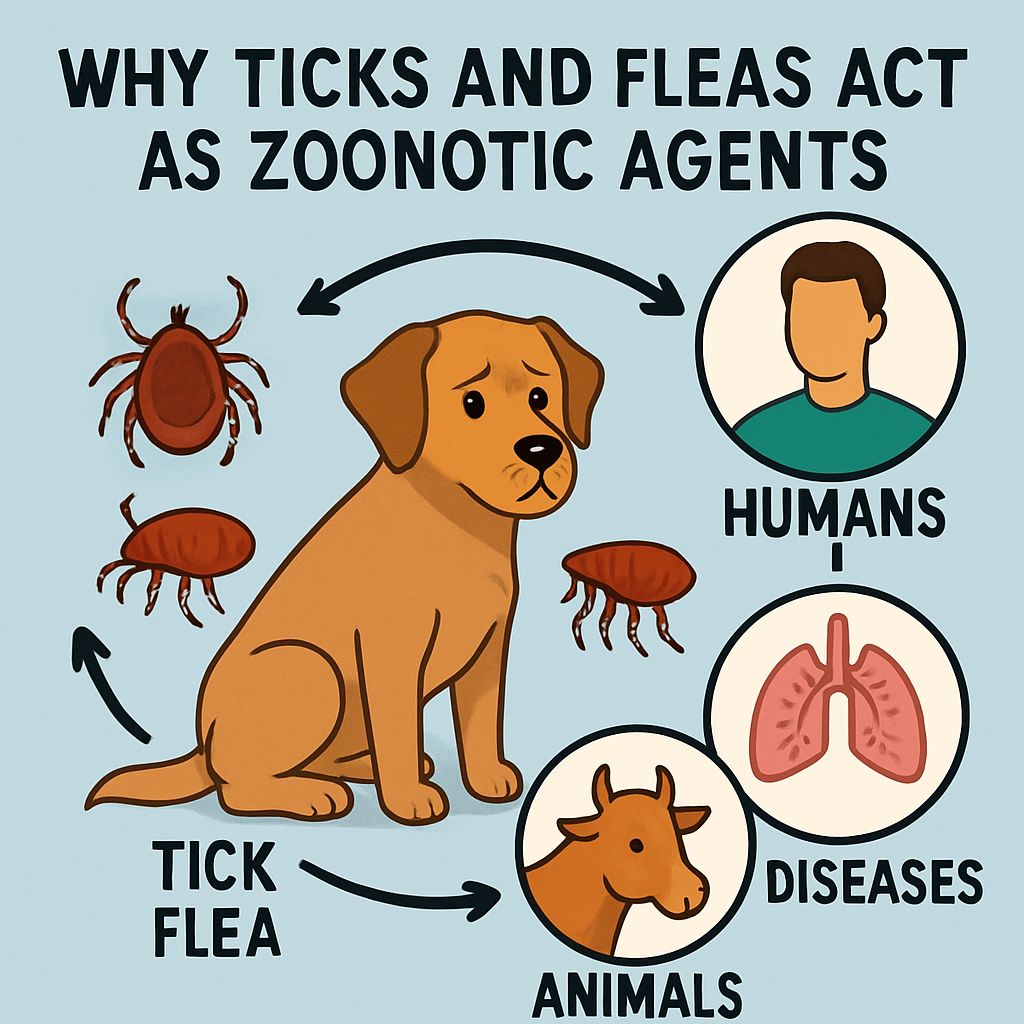
Ticks and fleas are considered zoonotic because they can transmit pathogens (bacteria, viruses, or parasites) from dogs to humans, either directly or indirectly. Here’s why they pose a risk to human health.
Diseases (Causalities) Caused by Tick and Flea Infestations
| Disease | Caused By | Transmitted By | Symptoms in Dogs | Symptoms in Humans | Zoonotic Risk |
|---|---|---|---|---|---|
| Lyme Disease | Borrelia burgdorferi (bacteria) | Ticks (e.g., black-legged tick) | Fever, lameness, joint pain, lethargy | Rash (bull’s-eye), fever, fatigue, arthritis | High; ticks can bite humans directly |
| Rocky Mountain Spotted Fever | Rickettsia rickettsii (bacteria) | Ticks (e.g., American dog tick) | Fever, vomiting, muscle pain, lethargy | Fever, rash, headache, muscle pain | High; ticks transmit to humans via bites |
| Ehrlichiosis | Ehrlichia species (bacteria) | Ticks (e.g., brown dog tick) | Fever, weight loss, bleeding tendencies | Fever, headache, muscle aches | Moderate; less common in humans |
| Murine Typhus | Rickettsia typhi (bacteria) | Fleas (via flea dirt) | Rare in dogs; mild fever, lethargy | Fever, chills, rash, headache | Moderate; humans exposed via flea dirt |
| Tapeworm Infection | Dipylidium caninum (parasite) | Fleas (ingested by dog or human) | Scooting, weight loss, visible worms | Abdominal pain, digestive issues (rare) | Low; humans ingest fleas accidentally |
| Cat Scratch Disease | Bartonella henselae (bacteria) | Fleas (via flea dirt or bites) | Often asymptomatic in dogs | Swollen lymph nodes, fever, fatigue | Moderate; rare but possible via flea exposure |
Final Thoughts
Preventing Ticks and Fleas Infestation on Dogs requires consistent care, hygiene, and veterinary guidance. Early detection and preventive action keep your dog healthy, comfortable, and protected from these harmful blood-feeding parasites.
Ticks and fleas may be small to see, but their impact on your dog and family can be huge. By doing regular checks, using vet-approved preventatives, and keeping the home and yard clean, you can prevent tick and flea infestations before they start. Save your furry friend from discomfort and serious health risks, and keep your home safe from zoonotic diseases. With a little caution we can keep our dog’s health and your family’s health good.
FAQs
How do I know if my dog has ticks or fleas?
Look for excessive scratching, biting, or licking. Fleas are small, fast-moving, and dark brown; ticks are larger, flat, and attach to the skin. Check ears, neck, belly, and between toes.
How can I prevent ticks and fleas on my dog?
Use vet-recommended preventatives like topical treatments, oral medications, or flea/tick collars. Keep your yard mowed and clean.
Are ticks and fleas dangerous to my dog?
Yes. Fleas can cause skin infections, allergies, or transmit tapeworms. Ticks can transmit diseases like Lyme disease or Rocky Mountain spotted fever.
How do I safely remove a tick from my dog?
Use fine-tipped tweezers to grasp the tick close to the skin and pull straight out slowly. Clean the area and your hands with alcohol. Don’t twist or crush the tick.
What’s the best way to treat a flea infestation?
Treat your dog with a vet-approved flea product, wash bedding, vacuum thoroughly, and treat your home/yard with pet-safe insecticides if needed.
Can ticks or fleas spread to humans?
Fleas can bite humans, causing irritation. Ticks can attach to humans and transmit diseases like Lyme disease. They don’t live on humans but can transfer.
How often should I check my dog for ticks and fleas?
Check daily during peak seasons (spring/summer for ticks, year-round for fleas in warm climates) or after outdoor activities in wooded or grassy areas.
Do natural remedies work for ticks and fleas?
Some, like diatomaceous earth or essential oil sprays, may help but are less effective than vet-recommended treatments. Always consult a vet before using.
Can my dog get ticks or fleas indoors?
Yes, fleas can thrive indoors, especially in warm, humid conditions. Ticks can be brought inside on clothing or pets but don’t typically infest homes.
How long does it take to get rid of a flea infestation?
With consistent treatment (dog, home, and yard), it can take 1–3 months to fully eliminate fleas, as eggs and larvae can persist.
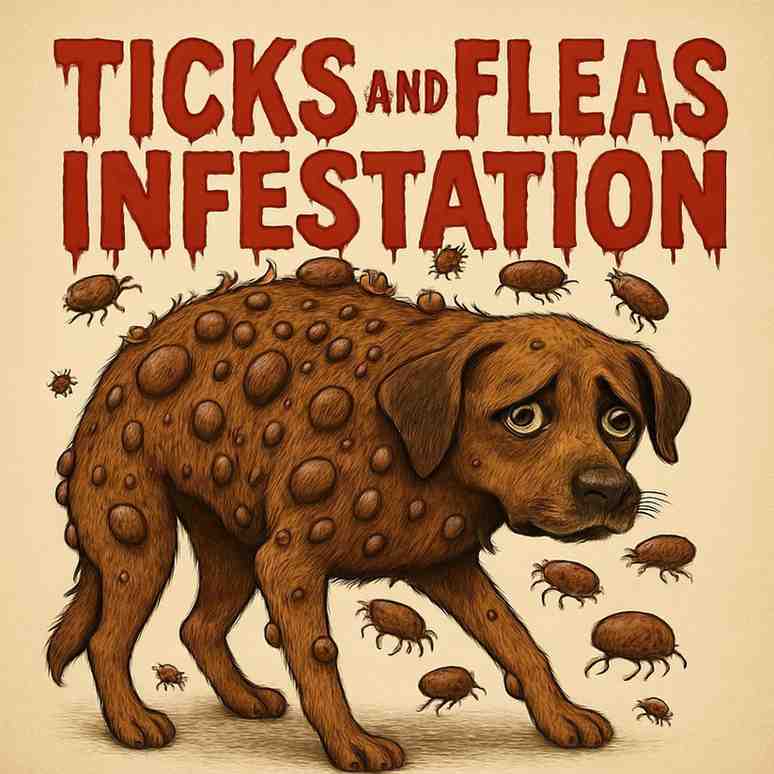
5 thoughts on “Ticks and Fleas Infestation on Dogs: Save Your Pet from These Tiny Terrors”